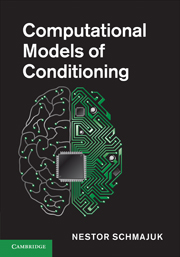Book contents
- Frontmatter
- Contents
- List of contributors
- Introduction
- 1 Evolution of attention in learning
- 2 The arguments of associations
- 3 The hybrid modeling approach to conditioning
- 4 Within-compound associations: models and data
- 5 Associative modulation of US processing: implications for understanding of habituation
- 6 Attention, associations, and configurations in conditioning
- 7 Computer simulation of the cerebellum
- 8 The operant/respondent distinction: a computational neural-network analysis
- Index
- References
4 - Within-compound associations: models and data
Published online by Cambridge University Press: 10 January 2011
- Frontmatter
- Contents
- List of contributors
- Introduction
- 1 Evolution of attention in learning
- 2 The arguments of associations
- 3 The hybrid modeling approach to conditioning
- 4 Within-compound associations: models and data
- 5 Associative modulation of US processing: implications for understanding of habituation
- 6 Attention, associations, and configurations in conditioning
- 7 Computer simulation of the cerebellum
- 8 The operant/respondent distinction: a computational neural-network analysis
- Index
- References
Summary
Abstract
During compound conditioning in which two or more cues are paired with an unconditioned stimulus (US), animals form associations between each cue and the US and associations between the cues (the latter of which are called within-compound associations). Most contemporary theories of associative learning assert that summation of cue–US associations drives negative mediation (e.g., blocking, overshadowing, and conditioned inhibition) because of their effects on the processing of the US representation. Using a computational modeling approach, we reviewed and simulated experiments that suggest that within-compound associations are necessary for cue interactions. A mathematical model that attributes all cue interactions to within-compound associations provided a better fit than a model that attributes negative mediation effects to variations in processing of the US. Overall, the results of this analysis suggest that within-compound associations are important for all cue interactions, including cue competition, conditioned inhibition, counteraction effects, retrospective revaluation, and second-order conditioning.
Within-compound associations: models and data
Pavlov (1927) discovered that both positive and negative mediation effects can occur when a target cue (X) is presented during training in conjunction with a nontarget cue (A). Positive mediation effects refer to situations in which the presence of A during training results in more excitatory behavioral control by X than if X was trained elementally. An example of positive mediation is second-order conditioning, which occurs when A–unconditioned stimulus (A–US) pairings (Phase 1) precede X–A pairings (Phase 2, which presumably establishes an X–A within-compound association), resulting in more excitatory conditioned responding to X than in a control condition lacking one or the other phase (Pavlov, 1927).
- Type
- Chapter
- Information
- Computational Models of Conditioning , pp. 108 - 149Publisher: Cambridge University PressPrint publication year: 2010

